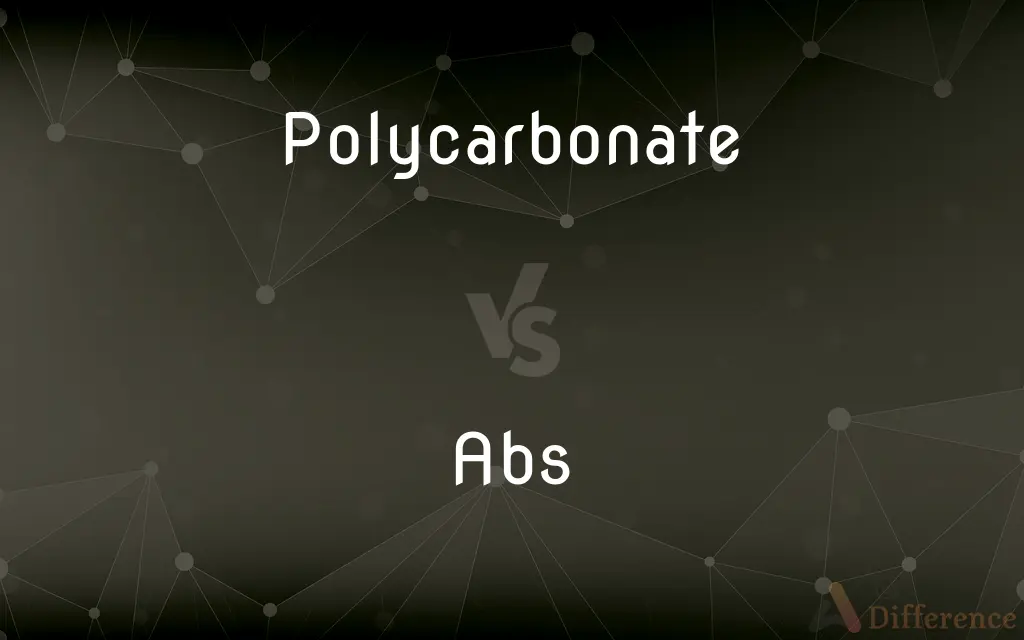Polycarbonate vs. ABS — What's the Difference?
By Urooj Arif & Maham Liaqat — Updated on May 7, 2024
Polycarbonate is a strong, transparent thermoplastic with high impact resistance, while ABS is a durable, opaque plastic known for its toughness and machinability.

Difference Between Polycarbonate and ABS
Table of Contents
ADVERTISEMENT
Key Differences
Polycarbonate is known for its transparency and clarity, often used where visibility or light transmission is essential. ABS, on the other hand, is opaque and chosen for applications where high impact resistance and ease of machining are crucial.
Polycarbonate provides excellent impact resistance, making it suitable for protective equipment like face shields. ABS also has good impact resistance but is preferred for consumer electronics due to its moldability.
Polycarbonate can withstand higher temperatures than ABS, offering better heat resistance. ABS, however, performs better at lower temperatures without becoming brittle.
Polycarbonate is often more expensive than ABS because of its enhanced properties like UV resistance and clarity. ABS is cost-effective, suitable for mass-produced products where budget considerations are key.
Polycarbonate is less resistant to certain chemicals than ABS. ABS exhibits greater resistance to chemicals and weathering, making it a good choice for outdoor applications.
ADVERTISEMENT
Comparison Chart
Transparency
Transparent, high clarity
Opaque
Impact Resistance
High impact resistance
Good impact resistance
Temperature Range
Higher heat resistance
Better performance at low temperatures
Cost
Generally more expensive
Cost-effective
Chemical Resistance
Less resistant
Better chemical and weather resistance
Compare with Definitions
Polycarbonate
Transparent thermoplastic.
Polycarbonate is used for safety goggles due to its clarity and strength.
Abs
Opaque thermoplastic.
ABS is used in most computer cases because it's tough and easy to mold.
Polycarbonate
High impact resistance.
Police riot shields often contain polycarbonate for maximum protection.
Abs
High impact resistance.
Many automotive components use ABS for its impact resistance.
Polycarbonate
UV resistance.
Some car headlights are made from UV-resistant polycarbonate.
Abs
Machinable.
The machinability of ABS makes it suitable for prototyping.
Polycarbonate
Electrical insulation.
Polycarbonate serves as a reliable electrical insulator in many appliances.
Abs
Weather resistance.
Outdoor playground equipment often incorporates ABS due to its weather resistance.
Polycarbonate
Lightweight alternative to glass.
Skylights and greenhouse panels use lightweight polycarbonate instead of glass.
Abs
Cost-effective.
ABS is a budget-friendly material for consumer products.
Polycarbonate
Polycarbonates (PC) are a group of thermoplastic polymers containing carbonate groups in their chemical structures. Polycarbonates used in engineering are strong, tough materials, and some grades are optically transparent.
Abs
Abbreviation of abstract
Polycarbonate
Any of a group of thermoplastics that are linear polyesters of carbonic acid, especially those derived from bisphenol A and phosgene, characterized by high-impact strength, light weight, and flexibility, and used as shatter-resistant substitutes for glass.
Abs
(informal) The abdominal muscles. ab
Polycarbonate
(chemistry) Any of a range of polymers of aromatic carbonates; they are used to make light, flexible alternatives to glass. Abbreviation: PC
Abs
Acronym of absolute temperature
Abs
(mathematics) absolute value function
Abs
The abductor muscles of the stomach; - a contraction used by body-building and health enthusiasts. Used similarly to pecs and delts.
Common Curiosities
What are the main uses of polycarbonate?
Polycarbonate is used in safety equipment, optical lenses, automotive parts, and lightweight windows due to its transparency and impact resistance.
Are both materials recyclable?
Yes, both polycarbonate and ABS can be recycled, although recycling processes may vary.
Which is more heat-resistant, polycarbonate or ABS?
Polycarbonate has better heat resistance, suitable for applications involving higher temperatures.
Are polycarbonate products UV-resistant?
Some polycarbonate products are UV-resistant, although untreated polycarbonate can degrade under prolonged UV exposure.
How does polycarbonate compare with ABS in terms of impact resistance?
Polycarbonate generally has higher impact resistance, suitable for heavy-duty applications.
Can ABS be used in outdoor applications?
Yes, ABS's resistance to weathering makes it useful for some outdoor applications, although prolonged exposure may still affect it.
Can both materials be 3D printed?
Yes, both polycarbonate and ABS can be used in 3D printing, but polycarbonate requires higher printing temperatures.
Why is ABS popular for consumer products?
ABS is cost-effective, easily molded, and has high impact resistance, making it suitable for electronics, toys, and automotive components.
How does the machinability of polycarbonate compare with ABS?
ABS is generally easier to machine, whereas polycarbonate requires more precision and care.
Is polycarbonate safe for food contact?
Food-grade polycarbonate is used in certain containers, although some concerns over BPA (bisphenol-A) exist.
Is ABS suitable for high-temperature environments?
ABS is generally suitable for temperatures up to around 80°C but is less heat-resistant than polycarbonate.
Which material is more expensive, polycarbonate or ABS?
Polycarbonate is generally more expensive due to its enhanced properties like clarity and heat resistance.
Which is more chemically resistant, polycarbonate or ABS?
ABS is generally more resistant to chemicals and solvents than polycarbonate.
Can polycarbonate be used in electronic enclosures?
Yes, polycarbonate's electrical insulation properties make it suitable for electronic enclosures.
Does ABS offer good sound insulation?
ABS provides moderate sound insulation, often used in automotive interiors and appliance housings.
Share Your Discovery

Previous Comparison
Apartment vs. House
Next Comparison
Few vs. LittleAuthor Spotlight
Written by
Urooj ArifUrooj is a skilled content writer at Ask Difference, known for her exceptional ability to simplify complex topics into engaging and informative content. With a passion for research and a flair for clear, concise writing, she consistently delivers articles that resonate with our diverse audience.
Co-written by
Maham Liaqat











































